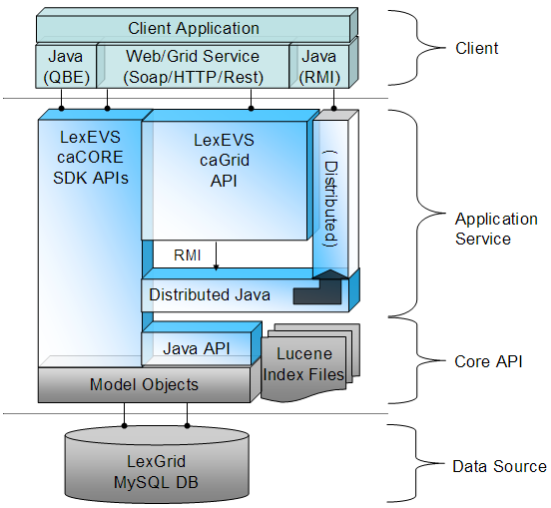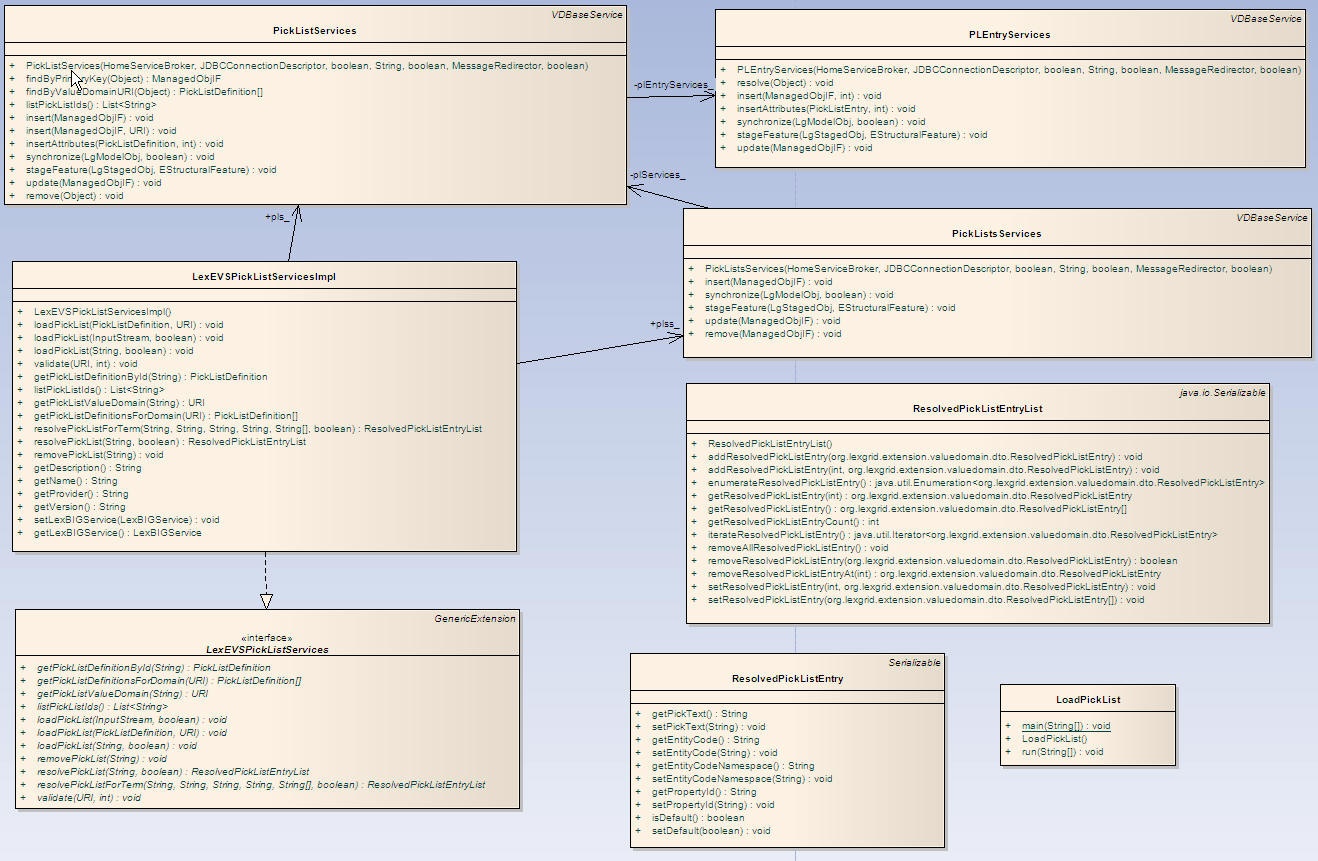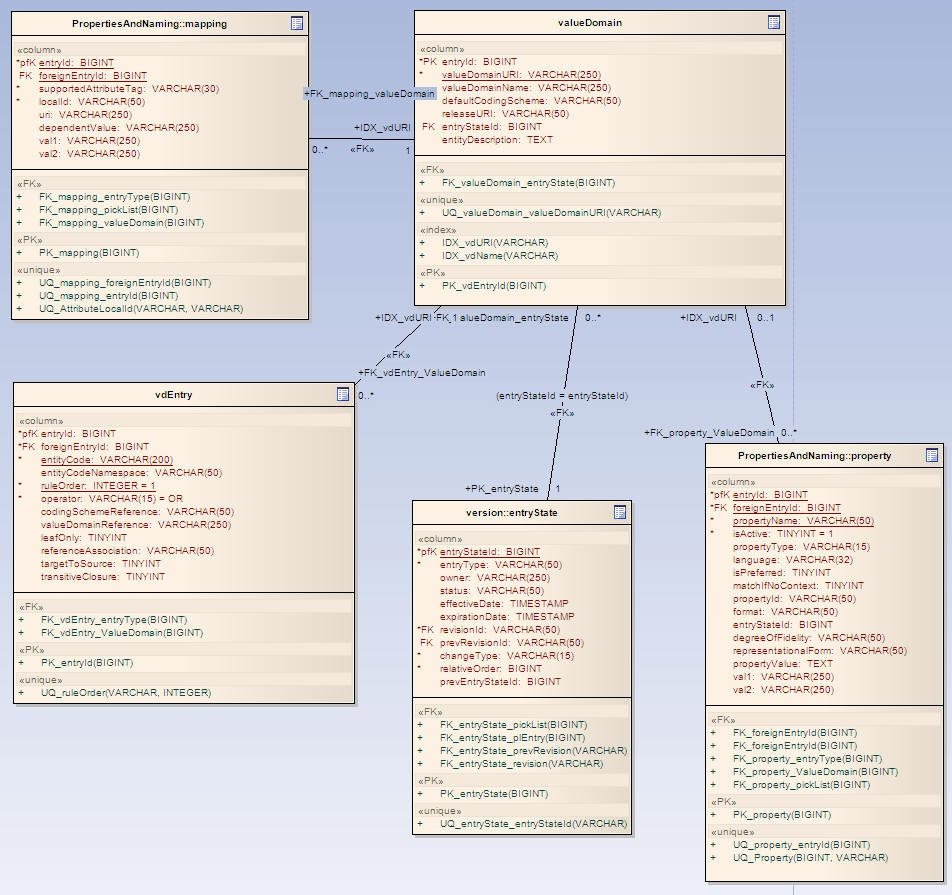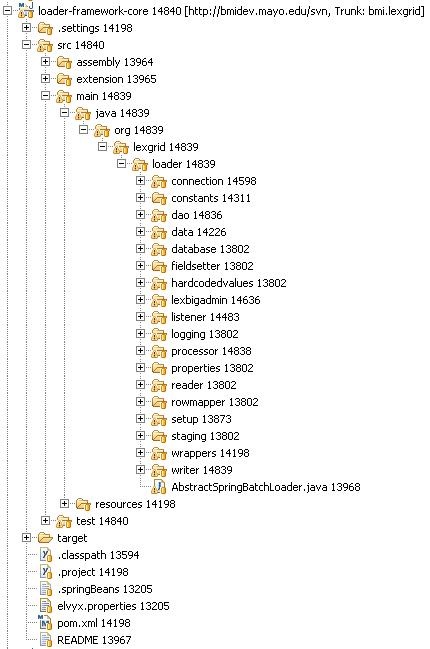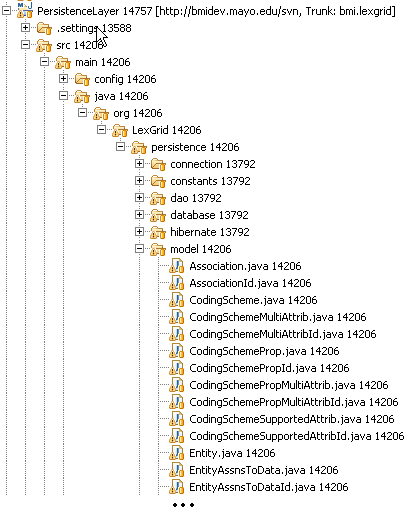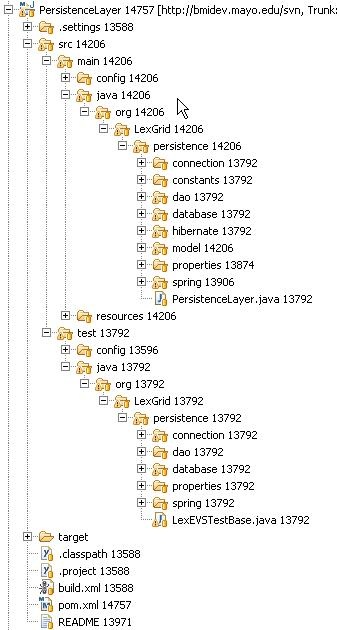 |
Page History
...
| Panel | ||
|---|---|---|
| ||
Author: Traci St.Martin/Craig Stancl/Kevin Peterson/Scott Bauer/Sridhar Dwarkanath/Mike Turk |
Sign off | Date | Role | CBIIT or Stakeholder Organization | Reviewer's Comments (If disapproved indicate specific areas for improvement.) |
|---|---|---|---|---|
— | — | — | — | — |
The purpose of this document is to collect, analyze, and define high-level needs for and designed features of the National Cancer Institute Center for Biomedical Informatics and Information Technology (NCI CBIIT) caCORE LexEVS Release 5.1. The focus is on the functionalities proposed by the stakeholders and target users to make a better product. The use case documents show in detail how the features meet these needs.
...
Data Source layer--- is responsible for storage and access to all data required to represent the objects returned through API invocation.
High Level Design Diagram
...
The LexEVS Value Domain and Pick List Service meant to expose the API particularly for the Value Domain and Pick List elements of the LexGrid Logical Model. For more information on LexGrid model see http://informatics.mayo.edu\\![]()
Improved Loader Framework
...
For example, an index of People may be indexed in Lucene as:
| No Format |
|---|
Document: id 1
First Name: John
Last Name: Doe
Sex: Male
Age: 45
Document: id 2
First Name: Jane
Last Name: Doe
Sex: Female
Age: 40
... etc.
|
...
- Lazy Retrieval
We can leverage this to increase performance in LexEVS. Consider this simplified LexEVS Entity index:
| No Format |
|---|
Document: id 1
Code: C12345
Name: Heart
Document: id 2
Code: C67890
Name: Foot
Document: id 3
Code: C98765
Name: Heart Attack
|
...
Class: | org.LexGrid.LexBIG.Extensions.Extendable.Search |
|---|---|
Method: | public org.apache.lucene.search.Query buildQuery(String searchText) |
Description: | Given a String search string, build a Query object to match indexed Lucene Documents |
...
WeightedDoubleMetaphoneQuery
This algorithm does not automatically assume that the user has spelled the terms incorrectly. Searches are also based on the actual text that the user has input, along with the Metaphone value.
Again, if the user input "Breast", the query will still match "Breast" and "Prostrate", but "Breast" will have a higher match score, because the actual user text is considered. This will add a greater precision to this fuzzy-type query.
Algorithm:
| No Format |
|---|
get: user text input
2: total score = 0
3: metaphone score = 0
4: actual score = 0
5: metaphone value = lucene.computeMetaphoneValue(user text input)
6: metaphone score = lucene.scoreMetaphoneValue(metaphone value)
7: actual score = lucene.score(user text input)
8: total score = metaphone score + actual score
9: halt
|
...
Also, a leading and trailing wildcard will be added, so
"th a heart atta"
Will also match:
"The patient with a heart attack was seen today".
Algorithm:
| No Format |
|---|
get: user text input
2: user text input = '*' + user text input + '*'
3: score = lucene.score(user text input)
4: halt
|
...
- Sorting on Different Class types
- A single Sort may be applicable for a variety of Class types. For instance, both an 'Association' and an 'Entity' may be sorted by 'Code', but the actual implementation of retrieving the Code and comparing it may be different between the two. It is the job of the Sort to implement a Comparator for each potential Class that it is eligible to sort.
- Default Sorting
- All result sets are sorted by default by Lucene Score, meaning that the best match according to Lucene will always be returned first by default. Note that if two or more result sets are being Unioned, Intersected, or Differenced, the user must explicitly call a 'matchToQuery' sort on the result set as a whole to order all of the results.
- Sort Contexts
- Sorts may be applicable in one or more 'Contexts' (see: org.LexGrid.LexBIG.DataModel.InterfaceElements.types.SortContext)
This means that a Sort may apply only to a CodedNodeSet, or only to a CodedNodeGraph, or some combination. Sorts will only be employed by the API if they match the Context in which the results are being sorted.
- Sorts may be applicable in one or more 'Contexts' (see: org.LexGrid.LexBIG.DataModel.InterfaceElements.types.SortContext)
- Performance Issues
- Sorting is generally computationally expensive, because in order to correctly sort, the field to be sorted has to be fully retrieved for the entire result set. For very specific or refined queries, this may not be a problem, but for large ontologies or very general queries, performance may be a concern. To alleviate this, 'Post sort' has been introduced.
- Post Sorting
In order to minimize the performance impact of sorting, users are encouraged to use a 'Post sort' where possible. A Post sort is done after the result set has been restricted, thus limiting the amount of information that must be retrieved in order to perform the sort. For instance, a query may match a set of Entities:
No Format {"Heart", "Heart Failure", "Heart Attack", "Arm", "Finger", ...}
As described earlier, all results are by default sorted by Lucene score, so if we limit the result set to the top 3, the result is:
| No Format |
|---|
{"Heart", "Heart Failure", "Heart Attack"}
|
The restricted set can then be 'Post' sorted - and because the result set has be limited to a reasonable number of matches, sorting and retrieval time can be minimized.
Algorithm:
| No Format |
|---|
1: get: Sort requested by user
2: get: Context sort is being applied to
3: if: sort is not valid for Context
halt
4: else:
5: get: Class to be sorted on
6: if: sort is not valid for Class
halt
7: get: Comparator for Sort - given (Class to be sorted on)
8: sort results using Comparator for Sort
9: halt
|
...
Code | Qualifier |
|---|---|
C01234 | isAnOrgan |
C98765 | isADisease |
| No Format |
|---|
SELECT * FROM Codes
|
Results in:
...
To get the Qualifiers, separate SELECTs must be used for each.
| No Format |
|---|
SELECT * FROM Qualifiers where Code = C01234
And
SELECT * FROM Qualifiers where Code = C98765
|
...
Code | Qualifier |
|---|---|
C01234 | isAnOrgan |
C98765 | isADisease |
| No Format |
|---|
SELECT * FROM Codes JOIN Qualifiers ON Code
|
...
Class Name | Description |
|---|---|
PickListsServices | Class to handle list of Pick List Definitions. |
PickListServices | Class to handle individual Pick List Definition objects to and fro database. |
PLEntryServices | Class to handle Pick List Entry objects to and fro database. |
LexEVSPickListServices | Primary interface for LexEVS Pick List API. |
LexEVSPickListServicesImpl | Implementation of LexEVSPickListServices which is primary interface for LexEVS Pick List API. |
LoadPickList | Imports the Pick List Definitions in the source file, provided in LexGrid canonical format, to the LexBIG repository. |
ResolvedPickListEntyList | Class to hold list of resolved pick list entries. |
ResolvedPickListEntry | Bean for resolved pick list entries. |
LexBIG Services Class Diagram
...
An interface to LexEVS Value Domain and Pick List Services could be obtained using an instance of LexBigService.
Information | getValueDomainService() |
|---|---|
Description: | Returns an interface to LexEVS Value Domain API. |
Input: | none |
Output: | org.lexgrid.valuedomain.LexEVSValueDomainServices |
Exception: | LBException |
Implementation Details: | Implementation: |
Information | getPickListService() |
|---|---|
Description: | Returns an interface to LexEVS Pick List API. |
Input: | none |
Output: | org.lexgrid valuedomain.LexEVSPickListServices |
Exception: | LBException |
Implementation Details: | Implementation: |
LexEVS Value Domain Service API - Loading Value Domain
...
Information | loadValueDomain(ValueDomainDefinition vddef, String systemReleaseURI) |
|---|---|
Description: | Loads supplied valueDomainDefinition object |
Input: | org.LexGrid.emf.valueDomains.ValueDomainDefinition, |
Output: | none |
Exception: | LBException |
Implementation Details: | Implementation: |
Information | loadValueDomain(InputStream inputStream,boolean failOnAllErrors)) |
|---|---|
Description: | Loads valueDomainDefinitions found in inputStream |
Input: | java.io.InputStream |
Output: | none |
Exception: | Exception |
Implementation Details: | Implementation: |
Information | loadValueDomain(String xmlFileLocation, boolean failOnAllErrors) | |
|---|---|---|
Description: | Loads valueDomainDefinitions found in input xml file | |
Input: | java.lang.String | |
Output: | none | |
Exception: | Exception | |
Implementation Details: | Implementation: |
|
Validate XML resources
Information | validate(URI uri, int valicationLevel) throws LBParameterException |
|---|---|
Description: | Perform validation of the candidate resource without loading data. |
Input: | java.net.URI |
Output: | none |
Exception: | Org.LexGrid.LexBIG.Exceptions.LBParameterException |
Implementation Details: | Implementation: |
Query Value Domain
Information | isConceptInDomain(String entityCode, URI valueDomainURI) |
|---|---|
Description: | Determine if the supplied entity code is a valid result for the supplied value domain and, if it is, return the particular codingSchemeVersion that was used. |
Input: | java.lang.String, |
Output: | org.LexGrid.LexBIG.DataModel.Core. AbsoluteCodingSchemeVersionReference |
Exception: | org.LexGrid.LexBIG.Exceptions.LBException |
Implementation Details: | Implementation: |
Information | isConceptInDomain(String entityCode, URI entityCodeNamespace, CodingSchemeVersionOrTag csvt, URI valueDomainURI) |
|---|---|
Description: | Similar to previous method, this method determine if the supplied entity code and entity namespace is a valid result for the supplied value domain when resolved against supplied Coding Scheme Version or Tag. |
Input: | java.lang.String, |
Output: | org.LexGrid.LexBIG.DataModel.Core. AbsoluteCodingSchemeVersionReference |
Exception: | org.LexGrid.LexBIG.Exceptions.LBException |
Implementation Details: | Implementation: |
Information | resolveValueDomain(URI valueDomainURI, AbsoluteCodingSchemeVersionReferenceList csVersionList) |
|---|---|
Description: | Resolve a value domain using the supplied set of coding scheme versions. |
Input: | java.net.URI, |
Output: | org.lexgrid.valuedomain.dto.ResolvedValueDomainDefinition |
Exception: | org.LexGrid.LexBIG.Exceptions.LBException |
Implementation Details: | Implementation: |
Information | isSubDomain(URI childValueDomainURI, URI parentValueDomainURI) |
|---|---|
Description: | Check whether childValueDomainURI is a child of parentValueDomainURI. |
Input: | java.net.URI, |
Output: | boolean |
Exception: | org.LexGrid.LexBIG.Exceptions.LBException |
Implementation Details: | Implementation: |
Information | getValueDomainDefinition(URI valueDomainURI) |
|---|---|
Description: | Returns value domain definition for supplied value domain URI. |
Input: | java.net.URI |
Output: | org.LexGrid.emf.valueDomains.ValueDomainDefinition |
Exception: | org.LexGrid.LexBIG.Exceptions.LBException |
Implementation Details: | Implementation: |
Information | listValueDomains(String valueDomainName) | |
|---|---|---|
Description: | Return the URI's for the value domain definition(s) for the supplied domain name. If the name is null, returns everything. If the name is not null, returns the value domain(s) that have the assigned name. | |
Input: | java.lang.String | |
Output: | java.net.URI[] | ]]></ac:plain-text-body></ac:structured-macro> |
Exception: | org.LexGrid.LexBIG.Exceptions.LBException | |
Implementation Details: | Implementation: | ]]></ac:plain-text-body></ac:structured-macro> |
Information | getAllValueDomainsWithNoNames() | |
Information | getAllValueDomainsWithNoNames() | ||
|---|---|---|---|
Description: | Return the | Description: | Return the URI's of all unnamed value domain definition(s). |
Input: | none | ||
Output: | java.net.URI[] | ]]></ac:plain-text-body></ac:structured-macro> | |
Exception: | org.LexGrid.LexBIG.Exceptions.LBException | ||
Implementation Details: | Implementation: | ]]></ac:plain-text-body></ac:structured-macro> |
Information | getValueDomainEntitiesForTerm(String term, URI valueDomainURI, String matchAlgorithm) |
|---|---|
Description: | Resolves the value domain supplied and restricts to the term and matchAlgorith supplied. Return object ResolvedValueDomainCodedNodeSet contains the codingScheme URI and Version that was used to resolve and the CodedNodeSet. |
Input: | java.lang.String, |
Output: | org.lexgrid.valuedomain.dto.ResolvedValueDomainCodedNodeSet |
Exception: | org.LexGrid.LexBIG.Exceptions.LBException |
Implementation Details: | Implementation: |
Information | getCodingSchemesInValueDomain(URI valueDomainURI) |
|---|---|
Description: | Returns list of coding scheme summary that is referenced by the supplied value domain. |
Input: | java.net.URI |
Output: | org.LexGrid.LexBIG.DataModel.Collections. AbsoluteCodingSchemeVersionReferenceList |
Exception: | org.LexGrid.LexBIG.Exceptions.LBException |
Implementation Details: | Implementation: |
Information | isDomain(String entityCode, String codingSchemeName, CodingSchemeVersionOrTag csvt) |
|---|---|
Description: | Determine if the supplied entity code is of type valueDomain in supplied coding scheme and, if it is, return the true, otherwise return false. |
Input: | java.lang.String, |
Output: | boolean |
Exception: | org.LexGrid.LexBIG.Exceptions.LBException |
Implementation Details: | Implementation: |
Remove Value Domain Definition
Information | removeValueDomain(URI valueDomainURI) |
|---|---|
Description: | Removes supplied value domain definition from the system. |
Input: | java.net.URI |
Output: | none |
Exception: | org.LexGrid.LexBIG.Exceptions.LBException, |
Implementation Details: | Implementation: |
Information | removeAllValueDomains() |
|---|---|
Description: | Removes all value domain definitions from the system. |
Input: | none |
Output: | none |
Exception: | org.LexGrid.LexBIG.Exceptions.LBException, |
Implementation Details: | Implementation: |
Drop Value Domain tables
Information | dropValueDomainTables() |
|---|---|
Description: | Drops value domain tables only if there are no value domain and pick list entries. |
Input: | none |
Output: | none |
Exception: | org.LexGrid.LexBIG.Exceptions.LBException, |
Implementation Details: | Implementation: |
LexEVS Pick List Service API
...
There are three methods that could be used to load Pick List Definitions :
Information | loadPickList(PickListDefinition pldef, String systemReleaseURI) |
|---|---|
Description: | Loads supplied Pick List Definition object |
Input: | org.LexGrid.emf.valueDomains.PickListDefinition, |
Output: | none |
Exception: | LBException |
Implementation Details: | Implementation: |
Information | loadPickList(InputStream inputStream, boolean failOnAllErrors) |
|---|---|
Description: | Loads Pick List Definitions found in inputStream |
Input: | java.io.InputStream |
Output: | none |
Exception: | Exception |
Implementation Details: | Implementation: |
Information | loadPickList (String xmlFileLocation, boolean failOnAllErrors) |
|---|---|
Description: | Loads Pick List Definitions found in input xml file |
Input: | java.lang.String |
Output: | none |
Exception: | Exception |
Implementation Details: | Implementation: |
Validate XML resources
Information | validate(URI uri, int valicationLevel) throws LBParameterException |
|---|---|
Description: | Perform validation of the candidate resource without loading data. |
Input: | java.net.URI |
Output: | none |
Exception: | Org.LexGrid.LexBIG.Exceptions.LBParameterException |
Implementation Details: | Implementation: |
Query Pick List
Information | getPickListDefinitionById(String pickListId) |
|---|---|
Description: | Returns pickList definition for supplied pickListId. |
Input: | java.lang.String |
Output: | org.LexGrid.emf.valueDomains.PickListDefinition |
Exception: | org.LexGrid.LexBIG.Exceptions.LBException |
Implementation Details: | Implementation: |
Information | getPickListDefinitionsForDomain(URI valueDomainURI) | ||
|---|---|---|---|
Description: | Returns all the pickList definitions that represents supplied valueDomain URI. | ||
Input: | java.net.URI | : | java.net.URI<ac:structured-macro ac:name="unmigrated-wiki-markup" ac:schema-version="1" ac:macro-id="0e1cfad5-6b41-403a-b98e-c7fdd691adf6"><ac:plain-text-body><![CDATA[ |
Output: | org.LexGrid.emf.valueDomains.PickListDefinition[] | ]]></ac:plain-text-body></ac:structured-macro> | |
Exception: | org.LexGrid.LexBIG.Exceptions.LBException | ||
Implementation Details: | Implementation: | ]]></ac:plain-text-body></ac:structured-macro> |
Information | getPickListValueDomain(String pickListId) |
|---|---|
Description: | Returns an URI of the represented valueDomain of the pickList. |
Input: | java.lang.String |
Output: | java.net.URI |
Exception: | org.LexGrid.LexBIG.Exceptions.LBException |
Implementation Details: | Implementation: |
Information | listPickListIds() |
|---|---|
Description: | Returns a list of pickListIds that are available in the system. |
Input: | none |
Output: | java.util.List<java.lang.String> |
Exception: | org.LexGrid.LexBIG.Exceptions.LBException |
Implementation Details: | Implementation: |
Information | resolvePickList(String pickListId, boolean sortByText) |
|---|---|
Description: | Resolves pickList definition for supplied pickListId. |
Input: | java.langString, |
Output: | org.lexgrid.valuedomain.dto.ResolvedPickListEntryList |
Exception: | org.LexGrid.LexBIG.Exceptions.LBException |
Implementation Details: | Implementation: |
Information | resolvePickListForTerm(String pickListId, String term, String matchAlgorithm, String language, String[] context, boolean sortByText) | ]]></ac:plain-text-body></ac:structured-macro> |
|---|---|---|
Description: | Resolves pickList definition by applying supplied arguments. | |
Input: | java.lang.String, | |
Output: | org.lexgrid.valuedomain.dto.ResolvedPickListEntryList | |
Exception: | org.LexGrid.LexBIG.Exceptions.LBException | |
Implementation Details: | Implementation: |
Remove Pick List Definition
Information | removePickList(String pickListId) |
|---|---|
Description: | Removes supplied Pick List Definition from the system. |
Input: | java.lang.String |
Output: | none |
Exception: | org.LexGrid.LexBIG.Exceptions.LBException, |
Implementation Details: | Implementation: |
Resolved Value Domain Objects
...
Parameter | Function |
|---|---|
-in | Input <uri> URI or path specifying location of the source file. |
-v | Validate <int> Perform validation of the candidate resource without loading data. |
Example:
| No Format |
|---|
sh LoadValueDomain.sh \-in "file:///path/to/file.xml"
|
...
Parameter | Function |
|---|---|
-in | Input <uri> URI or path specifying location of the source file. |
-v | Validate <int> Perform validation of the candidate resource without loading data. |
Example:
| No Format |
|---|
sh LoadPickList.sh \-in "file:///path/to/file.xml"
|
...
Below is a sample XML file containing Value Domain Definitions in LexGrid format that can be loaded using LexEVS Value Domain Service.
| Code Block | ||||
|---|---|---|---|---|
| ||||
<?xml version="1.0" encoding="UTF-8"?>
<systemRelease xmlns:xsi="http://www.w3.org/2001/XMLSchema-instance"
xsi:schemaLocation="http://LexGrid.org/schema/2009/01/LexGrid/versions http://LexGrid.org/schema/2009/01/LexGrid/versions.xsd"
xmlns="http://LexGrid.org/schema/2009/01/LexGrid/versions" xmlns:lgVer="http://LexGrid.org/schema/2009/01/LexGrid/versions"
xmlns:lgCommon="http://LexGrid.org/schema/2009/01/LexGrid/commonTypes" xmlns:data="data"
xmlns:lgVD="http://LexGrid.org/schema/2009/01/LexGrid/valueDomains" xmlns:lgNaming="http://LexGrid.org/schema/2009/01/LexGrid/naming"
releaseURI="http://testRelease/04" releaseDate="2008-11-07T14:55:51.615-06:00">
<lgCommon:entityDescription>Sample value domains</lgCommon:entityDescription>
<lgVer:valueDomains>
<lgVD:mappings>
<lgNaming:supportedAssociation localId="hasSubtype" uri="urn:oid:1.3.6.1.4.1.2114.108.1.8.1">hasSubtype</lgNaming:supportedAssociation>
<lgNaming:supportedCodingScheme localId="Automobiles" uri="urn:oid:11.11.0.1">Automobiles</lgNaming:supportedCodingScheme>
<lgNaming:supportedDataType localId="testhtml">test/html</lgNaming:supportedDataType>
<lgNaming:supportedDataType localId="textplain">text/plain</lgNaming:supportedDataType>
<lgNaming:supportedHierarchy localId="is_a" associationNames="hasSubtype" isForwardNavigable="true" rootCode="@">hasSubtype</lgNaming:supportedHierarchy>
<lgNaming:supportedLanguage localId="en" uri="www.en.org/orsomething">en</lgNaming:supportedLanguage>
<lgNaming:supportedNamespace localId="Automobiles" uri="urn:oid:11.11.0.1" equivalentCodingScheme="Automobiles">Automobiles</lgNaming:supportedNamespace>
<lgNaming:supportedProperty localId="textualPresentation">textualPresentation</lgNaming:supportedProperty>
<lgNaming:supportedSource localId="lexgrid.org">lexgrid.org</lgNaming:supportedSource>
<lgNaming:supportedSource localId="_111101">11.11.0.1</lgNaming:supportedSource>
</lgVD:mappings>
<lgVD:valueDomainDefinition valueDomainURI="SRITEST:AUTO:DomesticAutoMakers" valueDomainName="Domestic Auto Makers" defaultCodingScheme="Automobiles" effectiveDate="2009-01-01T11:00:00Z" isActive="true" status="ACTIVE">
<lgVD:properties>
<lgCommon:property propertyName="textualPresentation">
<lgCommon:value> Domestic Auto Makers</lgCommon:value>
</lgCommon:property>
</lgVD:properties>
<lgVD:definitionEntry ruleOrder="1" operator="OR">
<lgVD:entityReference entityCode="005" referenceAssociation="hasSubtype" transitiveClosure="true" targetToSource="false" leafOnly="false"/>
</lgVD:definitionEntry>
</lgVD:valueDomainDefinition>
<lgVD:valueDomainDefinition valueDomainURI="SRITEST:AUTO:AllDomesticButGM" valueDomainName="All Domestic Autos But GM" defaultCodingScheme="Automobiles" effectiveDate="2009-01-01T11:00:00Z" isActive="true" status="ACTIVE">
<lgVD:properties>
<lgCommon:property propertyName="textualPresentation">
<lgCommon:value> Domestic Auto Makers</lgCommon:value>
</lgCommon:property>
</lgVD:properties>
<lgVD:definitionEntry ruleOrder="1" operator="OR">
<lgVD:entityReference entityCode="005" referenceAssociation="hasSubtype" transitiveClosure="true" targetToSource="false" leafOnly="false"/>
</lgVD:definitionEntry>
<lgVD:definitionEntry ruleOrder="2" operator="SUBTRACT">
<lgVD:entityReference entityCode="GM" referenceAssociation="hasSubtype" transitiveClosure="true" targetToSource="false" leafOnly="false"/>
</lgVD:definitionEntry>
</lgVD:valueDomainDefinition>
<lgVD:valueDomainDefinition valueDomainURI="SRITEST:AUTO:AllDomesticANDGM" valueDomainName="All Domestic Autos AND GM" defaultCodingScheme="Automobiles" effectiveDate="2009-01-01T11:00:00Z" isActive="true" status="ACTIVE">
<lgVD:properties>
<lgCommon:property propertyName="textualPresentation">
<lgCommon:value> Domestic Auto Makers AND GM</lgCommon:value>
</lgCommon:property>
</lgVD:properties>
<lgVD:definitionEntry ruleOrder="1" operator="OR">
<lgVD:entityReference entityCode="005" referenceAssociation="hasSubtype" transitiveClosure="true" targetToSource="false" leafOnly="false"/>
</lgVD:definitionEntry>
<lgVD:definitionEntry ruleOrder="2" operator="AND">
<lgVD:entityReference entityCode="GM" referenceAssociation="hasSubtype" transitiveClosure="true" targetToSource="false" leafOnly="false"/>
</lgVD:definitionEntry>
</lgVD:valueDomainDefinition>
<lgVD:valueDomainDefinition valueDomainURI="SRITEST:AUTO:DomasticLeafOnly" valueDomainName="Domestic Leaf Only" defaultCodingScheme="Automobiles" effectiveDate="2009-01-01T11:00:00Z" isActive="true" status="ACTIVE">
<lgVD:properties>
<lgCommon:property propertyName="textualPresentation">
<lgCommon:value>Domestic Leaf Only</lgCommon:value>
</lgCommon:property>
</lgVD:properties>
<lgVD:definitionEntry ruleOrder="1" operator="OR">
<lgVD:entityReference entityCode="005" referenceAssociation="hasSubtype" transitiveClosure="true" targetToSource="false" leafOnly="true"/>
</lgVD:definitionEntry>
</lgVD:valueDomainDefinition>
</lgVer:valueDomains>
</systemRelease>
|
...
Below is a sample XML file containing Pick List Definitions in LexGrid format that can be loaded using LexEVS Pick List Service.
| Code Block | ||||
|---|---|---|---|---|
| ||||
<?xml version="1.0" encoding="UTF-8"?>
<systemRelease xmlns:xsi="http://www.w3.org/2001/XMLSchema-instance"
xsi:schemaLocation="http://LexGrid.org/schema/2009/01/LexGrid/versions http://LexGrid.org/schema/2009/01/LexGrid/versions.xsd"
xmlns="http://LexGrid.org/schema/2009/01/LexGrid/versions" xmlns:lgVer="http://LexGrid.org/schema/2009/01/LexGrid/versions"
xmlns:lgCommon="http://LexGrid.org/schema/2009/01/LexGrid/commonTypes" xmlns:data="data"
xmlns:lgVD="http://LexGrid.org/schema/2009/01/LexGrid/valueDomains" xmlns:lgNaming="http://LexGrid.org/schema/2009/01/LexGrid/naming"
releaseURI="http://testRelease/04" releaseDate="2008-11-07T14:55:51.615-06:00">
<lgCommon:entityDescription>Sample value domains</lgCommon:entityDescription>
<pickLists>
<lgVD:mappings>
<lgNaming:supportedCodingScheme localId="Automobiles" uri="urn:oid:11.11.0.1">Automobiles</lgNaming:supportedCodingScheme>
<lgNaming:supportedLanguage localId="en" uri="www.en.org/orsomething">en</lgNaming:supportedLanguage>
<lgNaming:supportedNamespace localId="Automobiles" uri="urn:oid:11.11.0.1" equivalentCodingScheme="Automobiles">Automobiles</lgNaming:supportedNamespace>
<lgNaming:supportedProperty localId="textualPresentation">textualPresentation</lgNaming:supportedProperty>
<lgNaming:supportedSource localId="lexgrid.org">lexgrid.org</lgNaming:supportedSource>
<lgNaming:supportedSource localId="_111101">11.11.0.1</lgNaming:supportedSource>
</lgVD:mappings>
<lgVD:pickListDefinition pickListId="SRITEST:AUTO:DomesticAutoMakers" representsValueDomain="SRITEST:AUTO:DomesticAutoMakers" isActive="true" defaultEntityCodeNamespace="Automobiles" defaultLanguage="en" completeDomain="false">
<lgCommon:owner>Owner for Domestic Auto Makers</lgCommon:owner>
<lgCommon:entityDescription>DomesticAutoMakers</lgCommon:entityDescription>
<lgVD:mappings>
<lgNaming:supportedCodingScheme localId="Automobiles" uri="urn:oid:11.11.0.1">Automobiles</lgNaming:supportedCodingScheme>
<lgNaming:supportedDataType localId="texthtml">text/html</lgNaming:supportedDataType>
<lgNaming:supportedDataType localId="textplain">text/plain</lgNaming:supportedDataType>
<lgNaming:supportedLanguage localId="en" uri="www.en.org/orsomething">en</lgNaming:supportedLanguage>
<lgNaming:supportedNamespace localId="Automobiles" uri="urn:oid:11.11.0.1" equivalentCodingScheme="Automobiles">Automobiles</lgNaming:supportedNamespace>
<lgNaming:supportedProperty localId="textualPresentation">textualPresentation</lgNaming:supportedProperty>
<lgNaming:supportedSource assemblyRule="rule1" uri="http://informatics.mayo.edu" localId="lexgrid.org">lexgrid.org</lgNaming:supportedSource>
<lgNaming:supportedSource localId="_111101">11.11.0.1</lgNaming:supportedSource>
</lgVD:mappings>
<lgVD:pickListEntryNode pickListEntryId="PLGMp1" isActive="true">
<lgCommon:owner>Owner for PLGMp1</lgCommon:owner>
<lgCommon:entryState containingRevision="R001" relativeOrder="1" changeType="NEW" prevRevision="R00A"/>
<lgVD:inclusionEntry entityCode="GM" entityCodeNamespace="Automobiles" propertyId="p1">
<lgVD:pickText>General Motors</lgVD:pickText>
</lgVD:inclusionEntry>
<lgVD:properties>
<lgCommon:property propertyName="textualPresentation" isActive="true" language="en" propertyId="p1" propertyType="presentation" status="active" effectiveDate="2001-12-17T09:30:47Z" expirationDate="2011-12-17T09:30:47Z">
<lgCommon:owner role="role" subRef="subref">General Motors</lgCommon:owner>
<lgCommon:entryState containingRevision="R001" relativeOrder="1" changeType="NEW" prevRevision="R00A"/>
<lgCommon:source subRef="subref1" role="role1">General Motors</lgCommon:source>
<lgCommon:value dataType="textplain">Property for General Motors</lgCommon:value>
</lgCommon:property>
</lgVD:properties>
</lgVD:pickListEntryNode>
<lgVD:pickListEntryNode pickListEntryId="PLGMp2" isActive="true">
<lgCommon:owner>Owner for PLGMp2</lgCommon:owner>
<lgCommon:entryState containingRevision="R001" relativeOrder="1" changeType="NEW" prevRevision="R00A"/>
<lgVD:inclusionEntry entityCode="GM" entityCodeNamespace="Automobiles" propertyId="p2">
<lgVD:pickText>GM</lgVD:pickText>
</lgVD:inclusionEntry>
</lgVD:pickListEntryNode>
<lgVD:pickListEntryNode pickListEntryId="PLJaguarp1" isActive="true">
<lgCommon:owner>Owner for PLJaguarp1</lgCommon:owner>
<lgCommon:entryState containingRevision="R001" relativeOrder="1" changeType="NEW" prevRevision="R00A"/>
<lgVD:inclusionEntry entityCode="Jaguar" entityCodeNamespace="Automobiles" propertyId="p1">
<lgVD:pickText>Jaguar</lgVD:pickText>
</lgVD:inclusionEntry>
</lgVD:pickListEntryNode>
<lgVD:pickListEntryNode pickListEntryId="PLChevroletp1" isActive="true">
<lgCommon:owner>Owner for PLChevroletp1</lgCommon:owner>
<lgCommon:entryState containingRevision="R001" relativeOrder="1" changeType="NEW" prevRevision="R00A"/>
<lgVD:inclusionEntry entityCode="Chevy" entityCodeNamespace="Automobiles" propertyId="p1">
<lgVD:pickText>Chevrolet</lgVD:pickText>
</lgVD:inclusionEntry>
</lgVD:pickListEntryNode>
</lgVD:pickListDefinition>
<lgVD:pickListDefinition pickListId="SRITEST:AUTO:DomasticLeafOnly" representsValueDomain="SRITEST:AUTO:DomasticLeafOnly" completeDomain="true" defaultEntityCodeNamespace="Automobiles" defaultLanguage="en" isActive="true">
<lgCommon:entityDescription>Leaf Only Nodes of Domastic AutoMakers</lgCommon:entityDescription>
</lgVD:pickListDefinition>
</pickLists>
</systemRelease>
|
Database structure
Value Domain Tables
Table Name | Description |
|---|---|
valueDomain | Will contain Value Domain Definition information |
vdEntry | Contains Value Domain Entries information and its rules |
entryState | Contains entry state details of every entry |
mappings | Contains supported mapping information for a Value Domain Definition |
property | Contains Property informations for Value Domain Definition |
...
- This Loader Framework requires LexEVS release 5.0 or above.
- Development system are required to install the Sun Java Development Kit (SDK) or Java Runtime Environment (JRE) version 1.5.0_11 or above.
- Maven 2.1 or greater.
- For software and hardware dependencies for the system hosting the LexEVS runtime, refer to the LexEVS 5.0 Documentation.
Issues
- None
Third Party Tools
...
An example may help in understanding the Framework. Our discussion will refer to the following figure. Lets say we are writing a loader to load the ICD-9-CM codes and their description which are contained in a text file. We know we'll need a data structure to hold the data after we've read it so we have a class:
| No Format |
|---|
ICD9SourceObject {
String id;
String descr;
String getId() { return id; }
}
|
...
Use these tags, 'beans:bean', to define the beans to be managed by the Spring container by specifying the packaged qualified class name. You can also specify inititialization values and set bean properties within these tags.
| Code Block | ||||
|---|---|---|---|---|
| ||||
<beans:bean id="umlsCuiPropertyProcessor" parent="umlsDefaultPropertyProcessor" class="org.lexgrid.loader.processor.EntityPropertyProcessor">
<beans:property name="propertyResolver" ref="umlsCuiPropertyResolver" />
</beans:bean>
|
...
The 'job' tag is the main unit of work. The job is comprised of one or more steps that define the work to be done. Other advanced and interesting things can be done within the Job such as using 'split' and 'flow' tags to indicate work that can be done in parellel steps to improve performance.
| Code Block | ||||
|---|---|---|---|---|
| ||||
<job id="umlsJob" restartable="true">
<step id="populateStagingTable" next="loadHardcodedValues" parent="stagingTablePopulatorStepFactory"/>
...
|
...
Below is an image of the loader-framework-core project in Eclipse which shows the key directories of the Loader Framework. The following is a summary of the contents of those directories.
Directory | Summary |
|---|---|
connection | Connect to LexBIG and do LexBIG tasks such as register and activate. |
constants | Assorted constants. |
dao | Access to the LexBIG database. |
data | Directly related to data going into the LexBIG database tables. |
database | Database specific tasks not related to data, such as finding out the database type (MySQL, Oracle) |
fieldsetter | Spring related classes for helping to write to the database. |
lexbigadmin | Common tasks you want LexBIG to do for you such as indexing. |
listener | You can attach listeners to a load so that the code will execute and certain points in the load such as a cleanup listener that runs when the load is finished or a setup listener etc... |
logging | Gives you access to the LexBIG logger. |
processor | Important directory. Contains classes that you can pass your domain specific object to and will return a LexBIG object. |
properties | Code used internally by the Loader Framework. |
reader | Readers and reader-related tools for loader developers. |
rowmapper | Classes for reading from a database. Currently experimental code. |
setup | Classes such as JobRepositoryManager that help Spring do its work. As Spring hums along it keeps tables of its internal workings. Loader developers should not need to dive into this directory. |
staging | If your loader needs to load data to the database temporarlily you can find helper classes in this directory. |
wrappers | Helper classes and data strucutres such as a Code/CodingScheme class. |
writer | Miscellaneous classes that write to the database. These are not the same ones you'd use in your loader, i.e the LexBIG model objects that use Hibernate. Those classes are contained in the PersistenceLayer project (next figure). It is by using those classes in the PersistenceLayer that you let the Loader Framework do some of the heavy lifting for you. |
Algorithms
None
...
Automated tests are run via Maven. As mentioned earlier the projects containing the Loader Framework code are configured to work with Maven. The following figure shows the PersistenceLayer project and its standard Maven layout. Notice the structure of the test code mirrors the structure of the application code. To run the automated test in our Eclipse environment we select the project, right click, select 'Run As' and select 'Maven test'. Maven will do the rest.
Test Guidelines
...
The LexEVS 5.1 project plan is located on the Gforge archive in MS Project format and PDF format
The LexEVS 5.1 BDA Project plan is located at LexEVS 5.1 BDA Project Plan (login required).
...
Documentation for LexEVS 5.1 will be provided by the Vocabulary Knowledge Center: LexEVS DocumentationGuides and Training.
Download center changes
Downloads for LexEVS 5.1 will be located on the LexEVS wiki.
...
